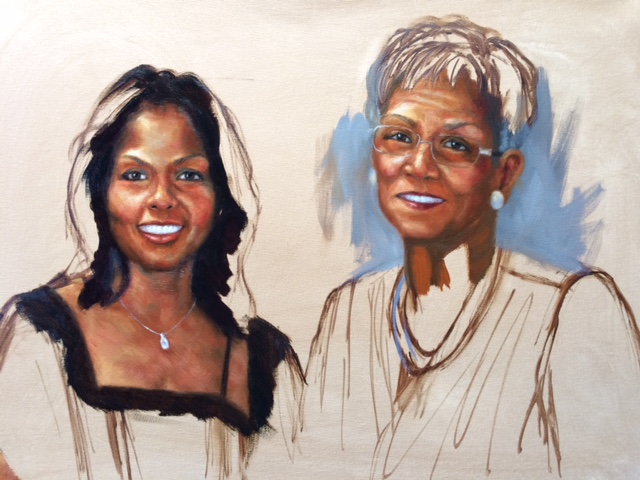At first glance, an oil portrait like this might simply look like a picture of two beautiful smiling people sharing a happy moment. But through the years I have learned and experienced that a portrait is not just a portrait. It is much more than that.
All portraits have one thing in common. They have a story to tell. This story begins (like all my previous portrait commissions) as a story about cherished loved ones who are being honored. And as the process begins one thing leads to another. Special memories are awakened that stir the viewer's heart and uplift the spirit. Emotions resurface that perhaps had laid dormant for a while. Loved ones are thought of and admired. A family heirloom is created.
There is power in a portrait.
 |
Mrs. Dianne Rhodes and Her Mother, Mrs. Emma Mae Grimes
18 x 24", Oil on canvas
Rita Salazar Dickerson |
Once the decision for the commission had been made the excitement and planning began. There were lots of reference photos to study and analyze. This is the main reference photo I chose to work from though I used several others as well. Many questions were asked from my clients. "What size should the canvas be? How long will the process take? What about the framing? Can we use a linen liner?" I enjoy this process; its exciting for me as well.
I love the freedom of making changes and using the photos for reference only. Adjustments were to be made with lighting, composition, clothing, jewelry...its all fun!
I started the painting with a thin mixture of burnt umber and mineral spirits which I used to paint in freehand the contour lines of their images. From there I worked on Mrs. Rhodes' (on the left) face first and then moved on to her mother's.
Half of the lovely large necklace was covered by Mrs. Grimes' dress and so I revealed the full piece for balance and design.
The black dresses were nice for continuity but I wasn't sure how I wanted to complete them. I then blocked in Mrs. Grimes' hair, preparing for the waves that would add contrast with light and shadow.
At this stage I focused on the details...completing the hair...softening edges...hi-lighting the jewelry...
...details that make a big difference. At my client's request I added Mrs. Rhodes' hidden right earring. I think it was a good suggestion.
With input from my clients, the final decision was made to complete the dresses to the edge of the canvas along with other minor adjustments throughout the entire painting.
Once the completed portrait is approved it is either picked up by the client or delivered to their home. But this story had a different ending.
The date was set. Every small detail was carefully planned. A surprise dinner party was to be held in honor of Mrs. Rhodes.
I had the extra special pleasure of being invited to the unveiling in Atlanta, Georgia and was asked to take part in the presentation.
 |
| Photo credit to Josef M. Courtney |
To my right is Ms. Cherita Lewis, and to my left is Mr. and Mrs. C.R. Rhodes
It was a special blessing to be there and an evening I will never forget.



























.jpg)

.JPG)
.JPG)
.JPG)
.JPG)
.JPG)
.JPG)
.JPG)
.JPG)
.JPG)
.JPG)
.JPG)
.JPG)
.JPG)
.JPG)
.JPG)
.JPG)
.JPG)
.JPG)
.JPG)
.JPG)
.JPG)

